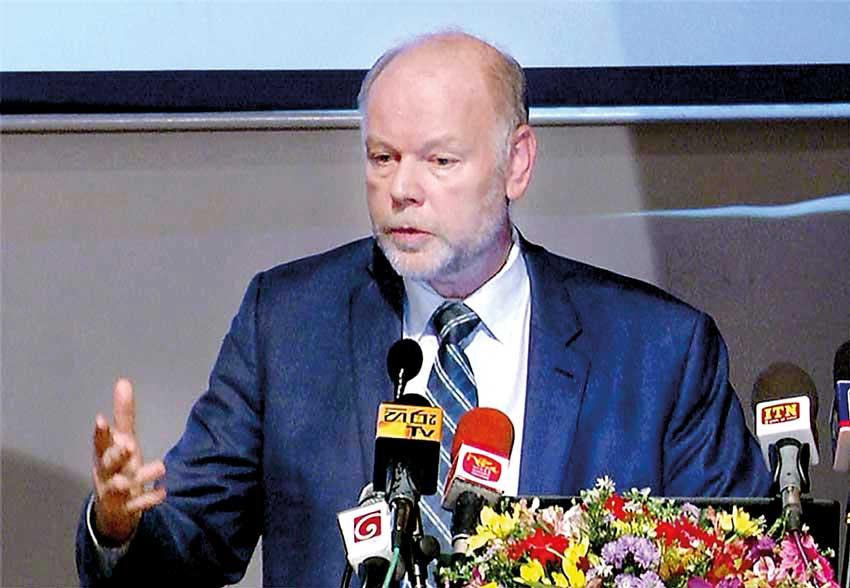02 Nov 2021 - {{hitsCtrl.values.hits}}

Hans Timmer
There are signs that the prolonged and unprecedented monetary and fiscal policy support extended to blunt the negative impacts on the pandemic on the broader economy has reached its limits, as the excesses are emerging by way of rising fiscal deficit, public debt and inflation, according to a World Bank economist.
Central banks and governments around the world immediately responded to the economic meltdown brought about by the pandemic last year through excessively high level of monetary and fiscal support, some of which still remain although many have either reversed part of such stimulus measures or have indicated in doing so in earnest.
According to World Bank Chief Economist for South Asia Hans Timmer, the economic malaise inflicted by the pandemic is more of a supply-side shock than a demand-side shock but the policy support unleashed by the central banks and governments almost entirely took the form of demand stimulus.
And that created a massive pent-up demand when economies reopen, contributing partly to the current supply chain bottlenecks and thereby the soaring commodities prices around the world and even shortages.
While a large section of people lost their livelihoods, another segment stockpiled their monthly paychecks; others received cash handouts by the governments and enjoyed the access to low-cost loans, which together created enormous demand in the economy.
Instead, he said what was required was relief to affected businesses and households and not a broad-based stimulus, which created a burst in demand to which the supply could not catch up with, as part of the supply is also hamstrung by the factory closures and other constraints created by the pandemic.
“What we are arguing in the report is that the limits of that kind of policy that happened during the crisis are in sight,” Timmer said in reference to the World Bank’s most recent publication titled ‘South Asia Economic Focus’.
“And that’s partly because the fiscal situation has become very difficult in most countries in South Asia. And that’s particularly true for Sri Lanka, specially when you have borrowed from international capital markets. Then it is becoming more and more difficult to sustain the debt service,” he added, speaking at a recent webinar organised by the Centre for Banking Studies of the Central Bank.
While Sri Lanka’s Central Bank has also provided trillions worth of liquidity support to both the government and private sector since the onset of the pandemic, expanding its balance sheet exponentially during the last 20 months, the Central Bank recently indicated that it would begin scaling it down in a more measured approach.
Joining a number of developed and developing markets’ central banks, Sri Lanka raised its key policy rates by 50 basis points in August, signalling that most of the pandemic era policy support is coming to an end.
Timmer also cautioned of the forbearance measures offered to the financial sector and other companies on their debt servicing and other standards during the crisis, as prolonged nature of such measures could mask the hidden risks and could threaten the financial system stability by way of rising non-performing loans.
“Also the limits to forbearance policy and relaxation of standards in financial markets are in sight now because it can actually be dangerous to continue to support companies that are not viable in the long run,” he said.
“That creates sharp increase in non-performing loans. In many countries it was already large before the crisis but now out of sight because of the support measures you can’t really see what non-performing loans are. If you continue too long in supporting the companies, at some point these non-performing loans will become visible and create a big problem,” Timmer added.
The Central Bank indicated last month that the payment relief offered on businesses and individuals on their loans for the fourth time would be gradually unwounded from next year and be replaced with long-term plans to support those who would continue to face challenges.
In this backdrop, Timmer called on the governments to shift their gears from support measures to laying a firm ground for sustainable medium-term growth, with buffers and social protection measures being created to make the economy and its actors, specially the more vulnerable segments, more shock proof in future crises.
24 Nov 2024 21 minute ago
24 Nov 2024 27 minute ago
24 Nov 2024 2 hours ago
24 Nov 2024 6 hours ago
24 Nov 2024 7 hours ago